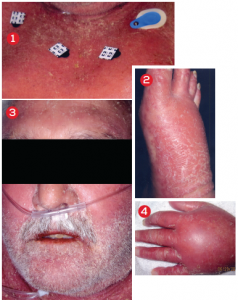Explore This Issue
ACEP Now: Vol 33 – No 09 – September 2014Temperature of 100.3°F and tachycardia at 122 beats per minute. His skin is noted to have a generalized beet-red, scaling rash that covers the majority of his body. Severe anasarca is noted and was most pronounced in his face and extremities.
The Case
A 65-year-old man with a history of psoriasis presents to the emergency department with a three-day history of subjective fever, polydipsia, and swelling of his face and extremities. Current medications: adalimumab and moxifloxacin.
His vital signs are remarkable for temperature of 100.3°F and tachycardia at 122 beats per minute. His skin is noted to have a generalized beet-red, scaling rash that covers the majority of his body. Severe anasarca is noted and was most pronounced in his face and extremities (see Figures 3 and 4).
The patient’s labs demonstrate a white blood cell count of 10.7×109 L and an elevated lactic acid of 5.8 mmol/L. The electrolyte panel shows evidence of acute renal insufficiency, with a creatinine of 2.45 mg/dL, and the albumin is noted to be low at 2.7 g/L. Chest X-ray and urinalysis are normal.
Diagnosis
The patient’s presentation is consistent with an erythrodermic psoriasis flare.
Erythrodermic psoriasis is the most severe form of psoriasis and is potentially life-threatening. It is characterized by a widespread, fiery erythematous rash and exfoliation often affecting the majority of the patient’s skin. Severe itching and pain, fluctuating body temperatures, and tachycardia are common.1
Acute management focuses on restoring intravascular volume, managing anasarca, and monitoring temperature instability. Recent research indicates that medications such as intravenous cyclosporine and infliximab that regulate epithelial cell growth and immune system response are usually effective, but therapy will be dictated by the patient’s condition and comorbidities.2 Secondary infection and development of septic shock can cause significant morbidity and mortality with erythrodermic psoriasis flares. Therefore, evaluation for underlying infection is critical.3

Figure 1. Red rash on the patient’s torso.
Figure 2. Scaling red rash on the patient’s foot.
Figure 3. Anasarca of the face.
Figure 4. Severe anasarca of patient’s hand.
To restore the patient’s intravascular volume, he is given aggressive intravenous hydration with normal saline. A 500 mL 5% albumin solution is also infused to mitigate the anasarca and hypoalbuminemia. Vital signs are monitored, and his tachycardia gradually resolves. The patient is pan cultured, and after consultation with the patient’s dermatologist, the patient is admitted to the hospital and started on intravenous cyclosporine.
During his hospital stay, the patient is seen by the infectious disease and nephrology services. The patient initially responds favorably to therapy, but subsequently develops worsening renal insufficiency, and the cyclosporine is discontinued in favor of adalimumab. The patient is started on intravenous antibiotics because some of the involved areas of skin appeared cellulitic.
On day four in the hospital, the patient is transferred to another facility to continue therapy under the direct care of his dermatologist. The anasarca has lessened, and his lactic acidosis and acute kidney injury have resolved. Blood cultures are negative, and the generalized fiery red rash has significantly improved.
There is disagreement on the epidemiology of psoriasis, but a recent meta-analysis concluded that the adult prevalence in the United States ranges from 2.2 percent to 3.15 percent.4 Erythrodermic psoriasis is estimated to affect between 1 percent and 2.25 percent of those who have psoriasis.5 While erythrodermic psoriasis can be associated with a high risk of deterioration and mortality due to secondary infection and sepsis, there are no data on mortality rates, due to the overall low incidence of erythrodermic psoriasis flares.5
Mr. Brock is a medical student at the University of Arizona College of Medicine in Tucson.
Dr. Hannafin is in the department of emergency medicine at Chandler Regional Medical Center in Chandler, Arizona.
Dr. LoVecchio is vice chair and research director at the Maricopa Medical Center in Phoenix and professor of emergency medicine, pharmacology, and medicine at the University of Arizona College of Medicine.
References
- Boyd AS. Menter A. Erythrodermic psoriasis: precipitating factors, course, and prognosis in 50 patients. J Am Acam Dermatol. 1989;21:985-91.
- Rosenbach M, Hsu S. Treatment of erythrodermic psoriasis: from the Medical Board of the National Psoriasis Foundation. J Am Acam Dermatol. 2010;62.4655-62.
- Green MS, Prystowsky JH. Infectious complications of erythrodermic psoriasis. J Am Acam Dermatol. 1996;5:911-14.
- Parisi R, Symmons DP, Griffiths EC. Global epidemiology of psoriasis: a systematic review of incidence and prevalence. J Invest Dermatol. 2013;133:377-85.
- Koo JY, Levin EC, Leon A, et al. Moderate to Severe Psoriasis, Fourth Edition. CRC Press. 2014;17:277-286.
Pages: 1 2 | Multi-Page





2 Responses to “Diagnosis, Treatment for Patient with Psoriasis, Fever, Bloating, and Rash”
August 10, 2017
Susan GeorgeNice article’ thanks for sharing.
January 15, 2019
Famma SVery informative. Thanks for sharing